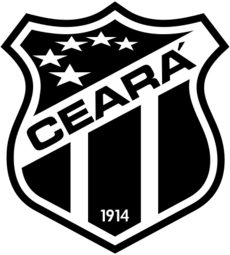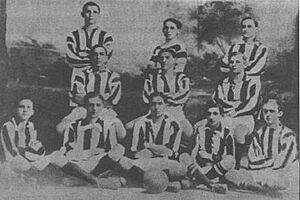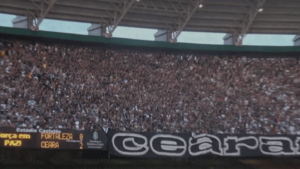Ceará Sporting Club facts for kids
 |
||||
| Full name | Ceará Sporting Club | |||
|---|---|---|---|---|
| Nickname(s) | Vozão (Big Grandpa) Vovô (Grandpa) Alvinegro Cearense (Black and White of Ceará) O Mais Querido (The Dearest) Campeão da Popularidade (Champion of Popularity) |
|||
| Founded | June 2, 1914 | |||
| Stadium | Castelão | |||
| Capacity | 63,903 | |||
| President | João Paulo Silva | |||
| Head coach | Léo Condé | |||
| League | Campeonato Brasileiro Série B Campeonato Cearense |
|||
| 2022 2022 |
Série A, 17th of 20 (relegated) Cearense, 6th of 10 |
|||
|
||||
Ceará Sporting Club, often called simply Ceará, is a professional football club from Fortaleza, the capital city of the Brazilian state of Ceará. The club was started on June 2, 1914.
Ceará is one of the most successful football clubs in the Northeast region of Brazil. They are known for their strong history alongside teams like Bahia and Sport. Ceará is the most popular team in its home state. They have won more games against their main rival, Fortaleza, than they have lost. Ceará is also the oldest and most traditional team in its state.
Contents
Club History: A Journey Through Time
How Ceará Sporting Club Started
On June 2, 1914, the club began as Rio Branco Football Club. It was founded by Luiz Esteves Junior and Pedro Freire. Seventeen other members soon joined them. The team's first colors were white and lilac. In 1915, on its first birthday, the club changed its name to Ceará Sporting Club. They won their first championship title in 1922.
Early Wins and Important Moments
In 1941, Ceará won the Campeonato Cearense, which is the state championship. This was the same year the Estadio Presidente Vargas opened. From 1961 to 1963, the club won the state championship three times in a row. In 1969, Ceará won the Northeast Cup. Their best performance in Brazil's top league, Serie A, was in 1964 when they finished third.
In 1970, the club won the state championship again after seven years. In 1971, Ceará played in the very first Campeonato Brasileiro Série A. From 1975 to 1978, they won the state championship four times in a row.
Big Games and International Play
In 1985, Ceará finished seventh in the national league, which was their second-best result. In 1994, they were runners-up in the Brazilian Cup, losing to Grêmio in the final. In 1995, Ceará played in the Copa CONMEBOL. This was the club's first international tournament. It made them the only club from Ceará State to play in an international competition at that time.
From 1996 to 1999, the club won the state championship four times in a row. During this time, the team's home shirt color changed to all black. This led to the nickname "Urubu do Nordeste" (Northeast Vulture). In 2005, Ceará reached the semifinals of the Copa do Brasil. They were defeated by Fluminense.
Return to the Top League and Recent Success
In 2010, Ceará returned to the Brazilian League after 17 years. They had a great start, staying unbeaten for eight matches. They even beat the champions, Fluminense. Ceará finished 12th that season, earning a spot in the Copa Sudamericana.
In 2011, Ceará reached the Copa do Brasil semi-finals. They famously beat Flamengo in the quarter-finals. Ceará won their first state championship in five years in 2011. This started a streak of four state titles in a row until 2014.
In February 2014, the Cidade Vozao – Luis Campos Training Center opened. This is where the club's youth teams train and where the first team practices.
In 2015, Ceará won their first Copa do Nordeste. They beat Bahia in the final. In 2018, they were promoted back to the top league. In 2020, the club won their second Copa do Nordeste. They finished eleventh in the Serie A, qualifying for the Copa Sudamericana.
In 2021, Ceará finished eleventh again and qualified for the 2022 Copa Sudamericana. They had a fantastic campaign, winning all their group stage matches. They reached the quarter-finals but lost to São Paulo in a penalty shootout.
Club Achievements: Trophies and Titles
Official Tournaments
| Regional | ||
|---|---|---|
| Competitions | Titles | Seasons |
| Copa do Nordeste | 3 | 2015, 2020, 2023 |
| Torneio Norte-Nordeste | 1s | 1969 |
| State | ||
| Competitions | Titles | Seasons |
| Campeonato Cearense | 47 | 1915, 1916, 1917, 1918, 1919, 1922, 1925, 1931, 1932, 1939, 1941, 1942, 1948, 1951, 1957, 1958, 1961, 1962, 1963, 1971, 1972, 1975, 1976, 1977, 1978, 1980, 1981, 1984, 1986, 1989, 1990, 1992, 1993, 1996, 1997, 1998, 1999, 2002, 2006, 2011, 2012, 2013, 2014, 2017, 2018, 2024, 2025 |
- record
- s shared record
Other Tournaments
Regional and Inter-state
- Zona Norte-Nordeste da Taça Brasil (1): 1964
- Taça Asa Branca (1): 2016
State
- Copa dos Campeões Cearenses (1): 2014
- Torneio Início do Ceará (12): 1922, 1923, 1926, 1932, 1936, 1937, 1943, 1947, 1952, 1953, 1967, 1978
Runners-up (Second Place)
- Copa do Brasil (1): 1994
- Copa do Nordeste (2): 2014, 2021
- Campeonato Cearense (26): 1924, 1933, 1943, 1952, 1959, 1964, 1965, 1966, 1969, 1970, 1973, 1974, 1985, 1987, 1991, 1994, 2000, 2001, 2004, 2009, 2010, 2015, 2019, 2020, 2021, 2023
- Copa dos Campeões Cearenses (2): 2018, 2019
Youth Team Achievements
- Campeonato Brasileiro Sub-23 (1): 2020
Women's Football Achievements
- Campeonato Brasileiro de Futebol Feminino Série A2 (1): 2022
- Campeonato Cearense de Futebol Feminino (5): 2018, 2019, 2021, 2023, 2024
Home Stadiums
Ceará's main training ground is Estádio Carlos de Alencar Pinto, which can hold 3,000 people. For bigger games and finals, the team plays at Estadio Castelão. This stadium has a much larger capacity of 60,326. They also use Presidente Vargas Stadium, which can hold 22,228 fans.
Club Rivals
Ceará's biggest rival is Fortaleza. The games between these two clubs are called Clássico Rei, meaning "King Derby." They have played 603 times. Ceará has won 213 of these matches, Fortaleza has won 187, and there have been 203 draws.
Ceará's second biggest rival is Ferroviário. This club is the third largest in Fortaleza city. Their matches are known as Clássico da Paz, or "Peace Derby." This derby has been played 302 times. Ceará has won 140 games, Ferroviário has won 71, and there have been 91 draws.
Team Mascot: Vovô the Grandpa
The team's mascot is an old man called "Vovô," which means "Grandpa." A cartoonist named Mino, who is from Ceará, created him.
The idea of the "grandpa" mascot started around 1919. Meton de Alencar Pinto, a former president of Ceará SC, was coaching young players. He used to call them his "grandsons." He would tell them to "go easy on grandpa." This nickname then started to be used for the Ceará team itself. It also fit because Ceará Sporting Club was the very first football team founded in the state.
Ceará Supporters
Ceará is the most supported football club in its state. It is also the third most supported club in the Northeast region of Brazil. Only Bahia and Sport have more fans. Ceará has about 1.6 million supporters.
Logo Evolution: How the Club's Look Changed
The first logo was used from 1915 to 1954. It was the club's first logo as Ceará Sporting Club.
The second logo was used from 1955 to 1969. It was inspired by the logo of the famous Santos club.
The third logo was used from 1970 to 2003. This version removed the football that was in the top left corner of the previous logo. It also added a white outline around the design.
The fourth logo is the club's current logo. It was adopted in 2003. This logo is a new version of the third logo, created by Adman Orlando Mota. This updated logo added white stars and the club's founding date.
Players: Who Plays for Ceará
First Team Squad
|
|
Youth Team Players
|
|
Players Out on Loan
|
|
Club Staff
Current Coaching and Medical Staff
| Position | Name |
|---|---|
| Coaching staff | |
| Head coach | |
| Assistant head coach | |
| Assistant head coach | |
| Goalkeepers trainer | |
| Goalkeepers trainer | |
| Performance analyst | |
| Performance analyst | |
| Performance analyst | |
| Medical staff | |
| Fitness coach | |
| Fitness coach | |
| Fitness coach | |
| Doctor | |
| Doctor | |
| Doctor | |
| Doctor | |
| Physiotherapist | |
| Physiotherapist | |
| Physiotherapist | |
| Physiotherapist | |
| Physiologist | |
| Nutriotionists | |
| Nutritionists | |
| Nutritionists | |
| Dentist | |
Managers: Who Has Coached Ceará
 Arnaldo Lira (1999)
Arnaldo Lira (1999) Lula Pereira (1999)
Lula Pereira (1999) Sérgio Ramirez d'Ávila (1999)
Sérgio Ramirez d'Ávila (1999) Celso Teixeira (1999–00)
Celso Teixeira (1999–00) Cláudio Duarte (2000)
Cláudio Duarte (2000) José Carlos Serrão (2000)
José Carlos Serrão (2000) Arnaldo Lira (2000–01)
Arnaldo Lira (2000–01) Júlio Espinosa (2001)
Júlio Espinosa (2001) Flávio Araújo (2001)
Flávio Araújo (2001) Artur Neto (2002)
Artur Neto (2002) Luis Carlos Cruz (2002–03)
Luis Carlos Cruz (2002–03) Dimas Filgueiras (2003)
Dimas Filgueiras (2003) Celso Teixeira (2003)
Celso Teixeira (2003) Ricardo Barreto (2004)
Ricardo Barreto (2004) Roberto Fernandes (2004)
Roberto Fernandes (2004) Lula Pereira (2004)
Lula Pereira (2004) Arnaldo Lira (2005)
Arnaldo Lira (2005) Lula Pereira (2004)
Lula Pereira (2004) Jair Pereira (2005)
Jair Pereira (2005) Valdir Espinosa (2005)
Valdir Espinosa (2005) Zé Teodoro (2006), (2009)
Zé Teodoro (2006), (2009) Paulo César Gusmão (2009–10)
Paulo César Gusmão (2009–10) René Simões (2010)
René Simões (2010) Estevam Soares (2010)
Estevam Soares (2010) Mário Sérgio (2010)
Mário Sérgio (2010) Vágner Mancini (2011)
Vágner Mancini (2011) Estevam Soares (2011)
Estevam Soares (2011) Paulo César Gusmão (2012)
Paulo César Gusmão (2012) Ricardinho (2013)
Ricardinho (2013) Sérgio Guedes (2013)
Sérgio Guedes (2013) Sérgio Soares (2013–14)
Sérgio Soares (2013–14) Paulo César Gusmão (2014)
Paulo César Gusmão (2014) Dado Cavalcanti (2015)
Dado Cavalcanti (2015) Silas Pereira (2015)
Silas Pereira (2015) Geninho (2015)
Geninho (2015) Marcelo Cabo (2015)
Marcelo Cabo (2015) Lisca (2015–16)
Lisca (2015–16) Sérgio Soares (2016)
Sérgio Soares (2016) Gilmar Dal Pozzo (2017)
Gilmar Dal Pozzo (2017) Givanildo Oliveira (2017)
Givanildo Oliveira (2017) Marcelo Chamusca (2017–18)
Marcelo Chamusca (2017–18) Jorginho (2018)
Jorginho (2018) Lisca (2018–19)
Lisca (2018–19) Enderson Moreira (2019)
Enderson Moreira (2019) Adílson Batista (2019)
Adílson Batista (2019) Argel Fuchs (2019–20)
Argel Fuchs (2019–20) Enderson Moreira (2020)
Enderson Moreira (2020) Guto Ferreira (2020–21)
Guto Ferreira (2020–21) Tiago Nunes (2021–22)
Tiago Nunes (2021–22) Dorival Júnior (2022)
Dorival Júnior (2022) Lucho González (2022)
Lucho González (2022) Gustavo Morínigo (2023)
Gustavo Morínigo (2023) Eduardo Barroca (2023)
Eduardo Barroca (2023) Guto Ferreira (2023)
Guto Ferreira (2023) Vagner Mancini (2023–2024)
Vagner Mancini (2023–2024) Léo Condé (2024–present)
Léo Condé (2024–present)
See also
 In Spanish: Ceará Sporting Club para niños
In Spanish: Ceará Sporting Club para niños




